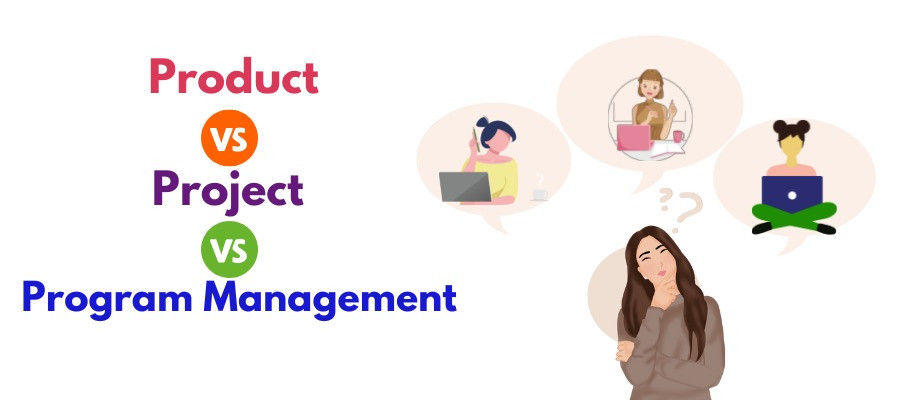Product vs Project vs Program Management

Do you need clarification while differentiating Product, Project, and Program Management as an Agile Beginner? Product management ensures the development of breakthrough products; Program management delivers successful initiatives based on company goals; and Project management considers an overall initiative with cross-functional efforts, more profound knowledge, and experience.
But these descriptive definitions need to be more complex to follow. Every Agile Practitioner must know the differences between Product, Project, and Program Management roles. This guide thoroughly discusses everything you must know about Product, Project, and Program Management.
Key Differences Based On The Purpose:
Product management’s primary purpose is to deliver high business value by planning, strategising, and delivering excellent product features. Product management serves the company’s product goals that help meet end-user needs and stakeholders’ expectations. The Product Owner or the Product Manager is responsible for efficient Product Management by planning Product Vision and Product Roadmap. The Product Owner oversees the product development lifecycle as he only defines the Product Goal for the development team to meet.
Project management’s primary purpose is to deliver the estimated team efforts on time and within the project’s budget. The Project Manager is responsible for establishing smooth coordination among all cross-functional teams under the project, including the Scrum Team, Development Team, Operations Team, and Testing Team. The Project Manager acts as an Agile Leader to drive the project towards success. Hence, project management entails building several work-scheduling timelines for the project teams. This all teammates can work on schedule while monitoring dependencies and identifying potential blockers that may delay the project’s timely delivery.
Program management’s primary purpose is to focus on successful outcomes after a collection of projects end or gets completed. Each program consists of several projects to derive the outcome of the program. Hence, the more projects get completed, the more successful the program becomes. The Program Manager drives the business’s long-term goals by assessing the ongoing projects and the outcomes. The Program manager thinks strategically to define the best practices to help improve various business processes.
Key Differences Based On Leadership:
Product Managers are responsible for creating the entire Product Roadmap. Product Managers also require leadership qualities to drive the cross-functional development teams together to achieve the Product Goal. Plus, Product Managers act as Business Experts with in-depth knowledge about the current market and its competitive landscape. This is the only way to identify top product features that add to the business value. Based on that, the Product Managers facilitate strategic planning with business stakeholders.
Project Managers are accountable only for the project’s delivery and success. From creating the project plan to managing the day-to-day operations of the cross-functional teams, the Project Manager does it all. Hence, the Project Manager requires Agile Leadership skills to ensure the delivery teams meet the project deadlines. As the Agile Leader, the Project Manager tracks work schedules, project budgets, resource utilization, and involved risks.
Program Managers also require leadership skills to plan and strategize the Program Roadmap that includes multiple project deliverables based on various company initiatives. The Program Manager leads the program schedule, performs budget planning, supervises the progress of different projects, and helps to steer organizational transformations. Program Managers also calculate resource utilization and measure business ROI to improve operational performance.
Primary Responsibilities Under Product Management:
- Planning and researching the Product Vision.
- Creating the Product Roadmap to support all life cycle stages.
- Finding products with a life cycle of growth and maturity.
- Forecasting a product that matches market expectations and satisfies end users.
- Managing the product’s go-to-market success.
Primary Responsibilities Under Project Management:
- Defined the project scope, budget, and resources.
- Manage unique project operations.
- Maintain the project completion phases of Initiation, Planning, Execution, Monitoring, and Controlling.
- Develop pre-defined project delivery timelines and milestones.
- Organize project workflows based on resource allocation.
- Provide on-time project delivery maintaining a strict budget.
Primary Responsibilities Under Program Management:
- Plan the program strategy from scratch based on business operation.
- Describe the program objectives and assesses probable business impacts.
- Plan a long-term program execution to continue after program completion.
- Translate the business’s strategic objectives into measurable goals.
- Implement business strategies that have true potential to succeed.
Conclusion : Importance of All Three Roles and Responsibilities
Product Owners, Project Managers, and Program Managers are equally responsible for meeting business goals and improving the end-user experience. Even though Agile Leaders have different roles and responsibilities, they bridge the company’s unique vision and its employees. Alongside focusing on their internal roles, Product, Project, and Program managers take utmost importance in noticing what is happening externally. These managerial roles come up with added responsibilities to ensure the business’s services meet market standards. Ideally, companies should hire skilled Agile Leaders for each of these roles!
If you aspire to become a CSM or CSPO, you must understand the difference in the positions of a Product Owner, Project Manager, and Program Manager. Indeed, it will help you develop a successful IT Career in the long run!
Reference
- https://medium.com/pm101/the-difference-between-product-program-and-project-management-64e2f1ee4f01



